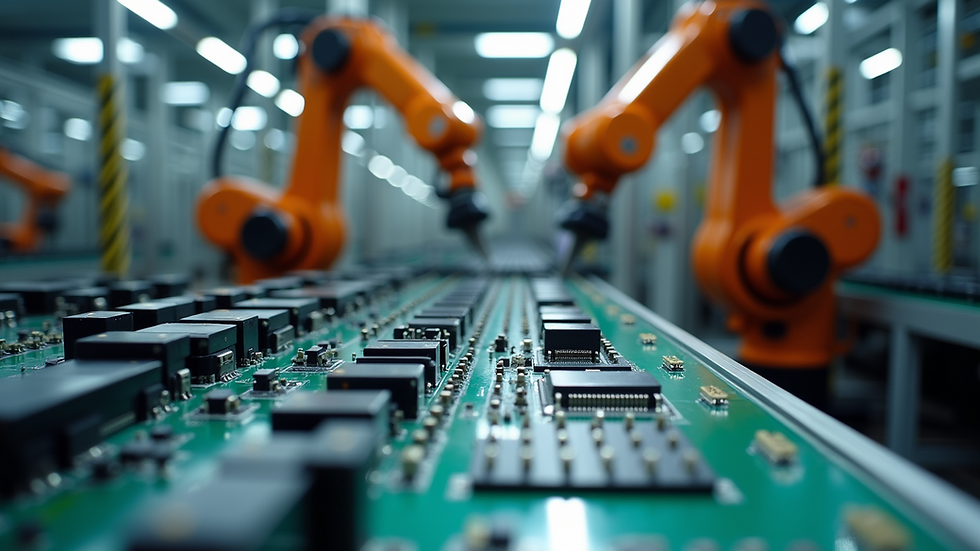Enhancing Product Development with AI Technologies
- Joseph Fuentes
- 5 days ago
- 4 min read
Product development has always been a complex process involving multiple stages, from idea generation to final launch. Today, artificial intelligence (AI) is transforming how companies create, test, and improve products. By integrating AI technologies, teams can reduce development time, improve product quality, and better meet customer needs. This post explores how AI enhances product development and offers practical examples of its application.
How AI Changes Product Development
AI brings new capabilities that were not possible before. It can analyze large amounts of data quickly, identify patterns, and make predictions. These abilities help product teams make smarter decisions throughout the development cycle.
Faster Idea Generation and Concept Testing
Generating ideas is the first step in product development. AI tools can scan market trends, customer feedback, and competitor products to suggest promising concepts. For example, natural language processing (NLP) algorithms analyze social media posts and reviews to find unmet customer needs.
Once ideas are generated, AI can simulate product concepts to test feasibility. Virtual prototyping powered by AI reduces the need for physical models, saving time and cost. This approach allows teams to explore more ideas before committing resources.
Improving Design with AI Assistance
Design is a critical phase where AI can add value by automating repetitive tasks and enhancing creativity. Generative design algorithms create multiple design options based on specified constraints such as materials, cost, and performance goals. Designers can then select or refine the best options.
AI also helps optimize product features by analyzing user behavior data. For instance, AI can identify which features customers use most and suggest improvements or simplifications. This data-driven design approach leads to products that better fit user preferences.

Eye-level view of a 3D printer creating a prototype model, demonstrating AI's role in rapid prototyping
Streamlining Testing and Quality Assurance
Testing products thoroughly is essential but often time-consuming. AI accelerates this process by automating tests and detecting defects early. Machine learning models can analyze test results to predict potential failures and suggest corrective actions.
For example, in software development, AI-powered testing tools automatically generate test cases and identify bugs faster than manual testing. In manufacturing, AI systems monitor production lines in real time to spot quality issues before products reach customers.
Enhancing Collaboration and Decision-Making
AI tools improve communication and collaboration among product teams. Intelligent project management platforms use AI to prioritize tasks, allocate resources, and forecast timelines based on historical data. This helps teams stay on track and avoid bottlenecks.
AI also supports decision-making by providing insights from data analysis. Product managers can use AI dashboards to track key performance indicators (KPIs) and customer feedback, enabling faster and more informed choices.
Real-World Examples of AI in Product Development
Several companies have successfully integrated AI into their product development processes. Here are a few examples:
Automotive Industry: Tesla uses AI to design and test vehicle components. Their AI-driven simulations help improve safety features and battery performance without extensive physical testing.
Consumer Electronics: Samsung employs AI to analyze customer feedback and usage data, guiding the design of smartphones and appliances that better meet user needs.
Fashion and Apparel: Nike uses AI to generate new shoe designs based on market trends and customer preferences, speeding up the design cycle and increasing product variety.
Pharmaceuticals: AI accelerates drug discovery by predicting molecular interactions and identifying promising compounds, reducing the time needed to develop new medicines.
Practical Tips for Integrating AI into Your Product Development
If you want to bring AI into your product development, consider these steps:
Start with clear goals: Identify specific challenges or stages where AI can add value, such as speeding up prototyping or improving quality control.
Collect quality data: AI depends on good data. Ensure you have accurate, relevant data from customer feedback, testing, or production.
Choose the right tools: Select AI platforms or software that fit your industry and development needs. Many solutions offer user-friendly interfaces for non-experts.
Train your team: Educate your product team on AI capabilities and limitations. Encourage collaboration between AI specialists and product experts.
Test and iterate: Begin with pilot projects to evaluate AI’s impact. Use feedback to refine AI models and expand their use gradually.
Challenges to Keep in Mind
While AI offers many benefits, it also presents challenges:
Data privacy: Handling customer data requires strict privacy measures and compliance with regulations.
Bias in AI models: AI can reflect biases present in training data, leading to unfair or inaccurate results.
Integration complexity: Adding AI to existing workflows may require technical adjustments and change management.
Cost and resources: Developing or adopting AI solutions can be expensive and resource-intensive.
Being aware of these issues helps companies plan better and avoid pitfalls.
The Future of Product Development with AI
AI will continue to evolve and play a bigger role in product development. Emerging technologies like augmented reality (AR) combined with AI will enable immersive design reviews. AI-driven personalization will allow products to adapt dynamically to individual users.
Companies that embrace AI thoughtfully will gain a competitive edge by delivering better products faster and more efficiently. The key is to use AI as a tool that supports human creativity and judgment, not as a replacement.
Enhancing product development with AI technologies offers clear benefits in speed, quality, and customer focus. By understanding how AI fits into each stage and addressing challenges, teams can unlock new possibilities. Start exploring AI tools today to improve your product development process and meet the demands of tomorrow’s market.


Comments